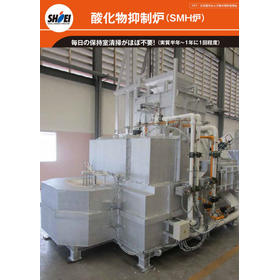Electric resistance melting furnace (for precious metal reduction recycling)
A valuable metal reduction recycling melting furnace that reduces metal oxides contained in the copper and precious metals found in the incineration residues of waste circuit boards, as well as in by-products from stainless steel manufacturing processes, through carbon reduction. ■ Equipment Features - By immersing electrodes in the molten slag, high-efficiency melting is possible due to the Joule heat generated directly within the slag. - Complete melting of the treated materials in the furnace allows for easy separation of metal and slag.
Inquire About This Product
basic information
■Examples of Use - Incineration residues from electronic substrates (gold, silver, copper, lead, tin, etc.) - Various waste catalysts (platinum group metals, vanadium, molybdenum, etc.) - Dust from metal melting furnaces and acid washing neutralization sludges (stainless steel) - Separation of molten metal from metal-containing slag (non-ferrous smelting slag, etc.) - Incineration residues from the removal of resin components (combustible components) from waste substrates using existing incinerators - Briquetted plating sludge, etc. ■Examples of Metal Reduction Reactions - Nickel: NiO + C → Ni + CO - Chromium: Cr2O3 + 3C → 2Cr + 3CO - Iron: FeO + C → Fe + CO - Iron: Fe2O3 + 3C → 2Fe + 3CO - Manganese: MnO + C → Mn + CO The above reduction reactions proceed in the furnace, recovering metals from oxide raw materials. ■Example of a Valuable Metal Recycling System in a Melting Reduction Furnace A system that processes incineration residues from the combustion of combustible components such as resins in waste substrates in an incinerator, recovering metals through melting reduction treatment.
Applications/Examples of results
Company information
"An Innovator in Thermal Technology Supporting Society with the Power of Heat" Tanabe has developed "thermal technology" over the course of a century since its founding. This thermal technology has been applied and utilized in various forms to meet the needs of the times. How to reduce waste, how to reuse limited resources, and how to reduce greenhouse gases. Tanabe, the "innovator in thermal technology," takes on the challenges of the era with thermal technology. "A Century of Pursuing Thermal Technology" Tanabe's history began with the maintenance of electric furnaces owned by local companies. In 1957, it manufactured and delivered its first electric furnace, transforming into a manufacturer of electric furnaces for the steel industry. Since then, it has provided a wide range of industrial furnaces, including various melting furnaces, rotary kilns, and oven furnaces, targeting diverse industries.








![Single End Radiant Tube Burner [TRF Burner]](https://image.mono.ipros.com/public/product/image/c08/2000793597/IPROS40624651388633756578.png?w=280&h=280)
![Inclined immersion type electric heater holding furnace [oxide reduction type]](https://image.mono.ipros.com/public/product/image/c7e/2000804160/IPROS67190141477188481135.jpeg?w=280&h=280)
![Butterfly Valve BV Series [2D/3D CAD]](https://image.mono.ipros.com/public/product/image/7a0/2000815776/IPROS65074472961613162442.jpeg?w=280&h=280)
![Venturi Mixer VM Series [2D/3D CAD]](https://image.mono.ipros.com/public/product/image/d2e/2000852305/IPROS58786938329892851049.png?w=280&h=280)